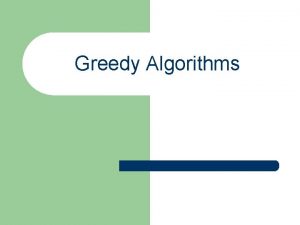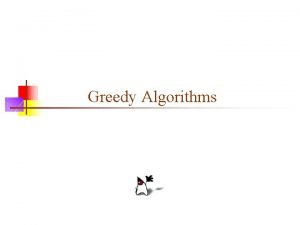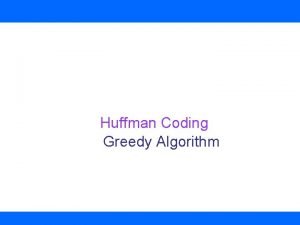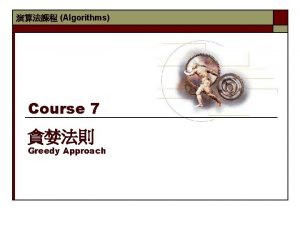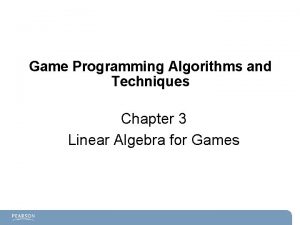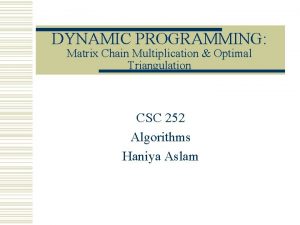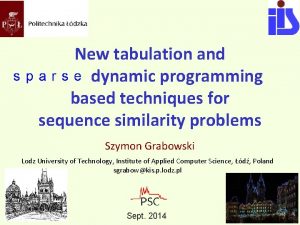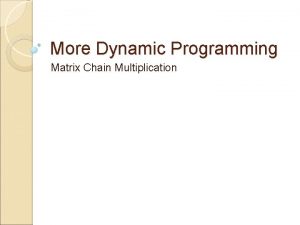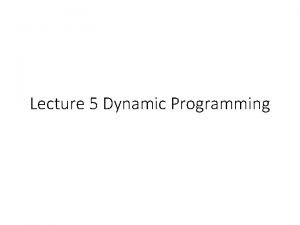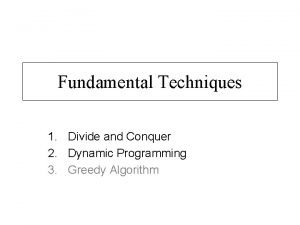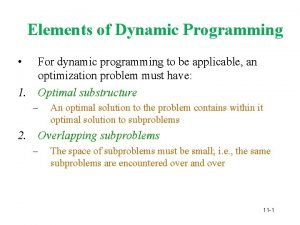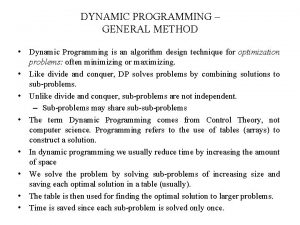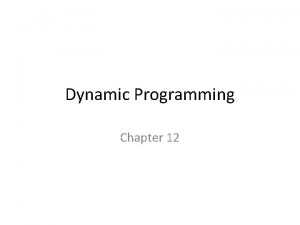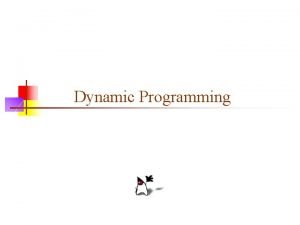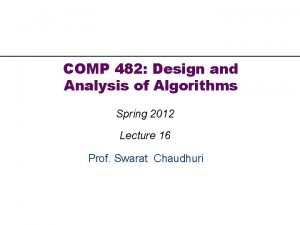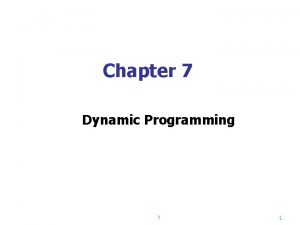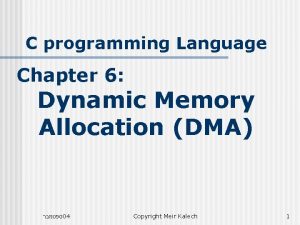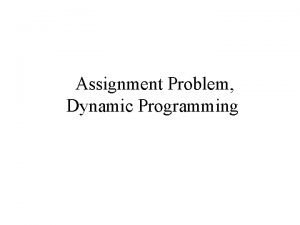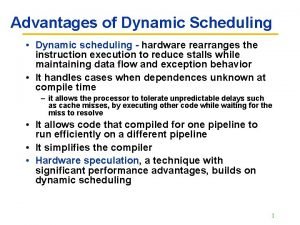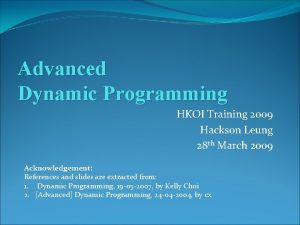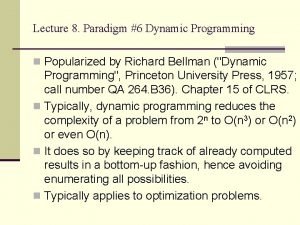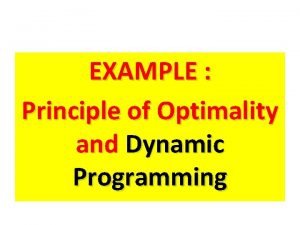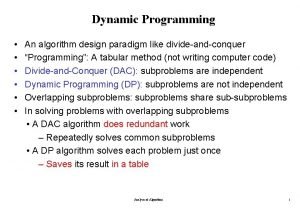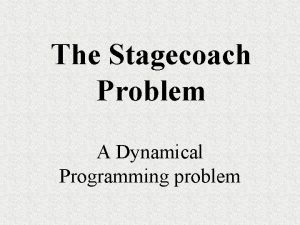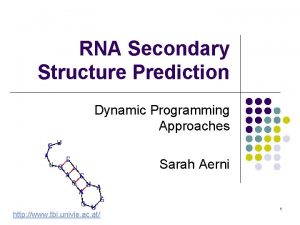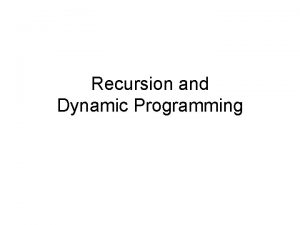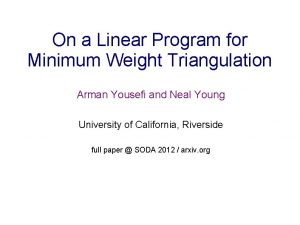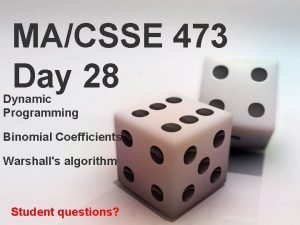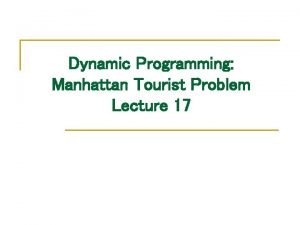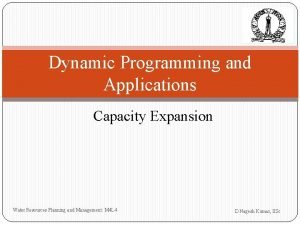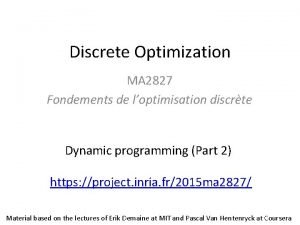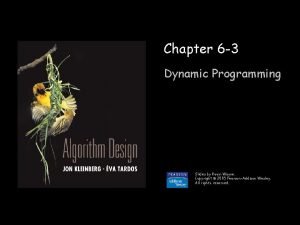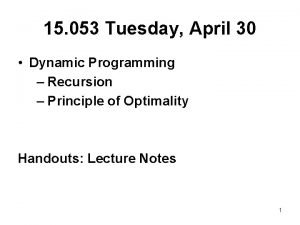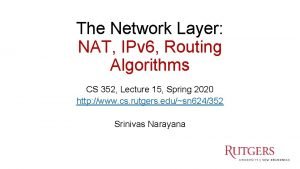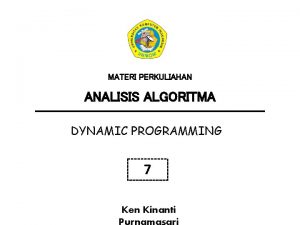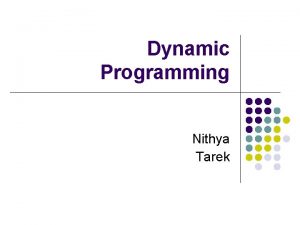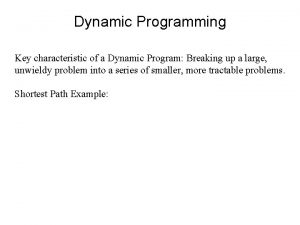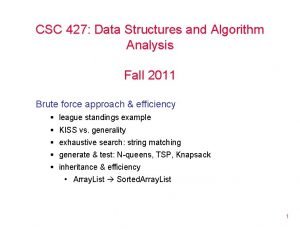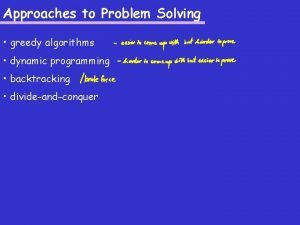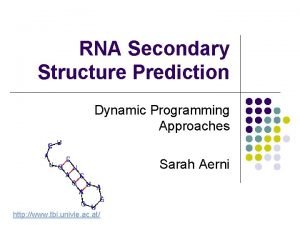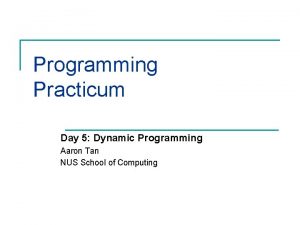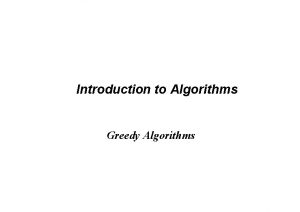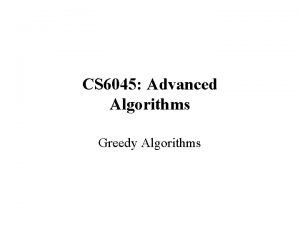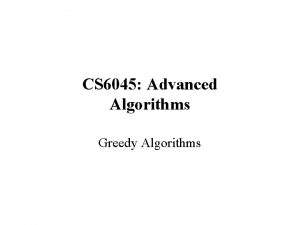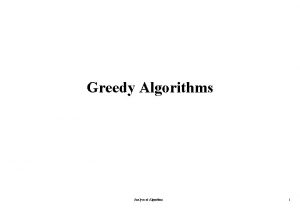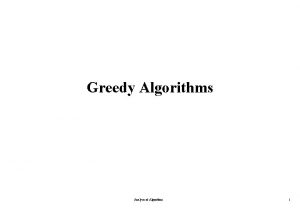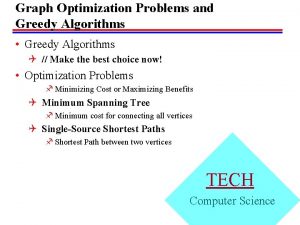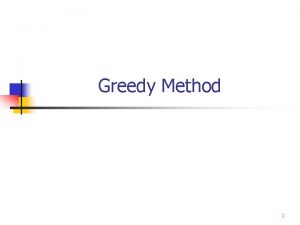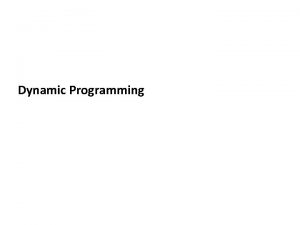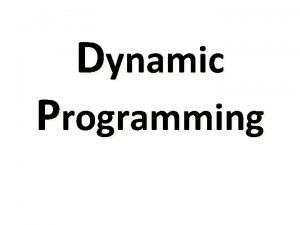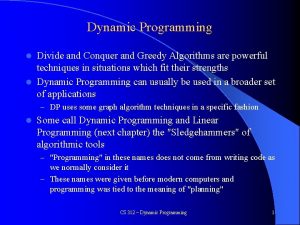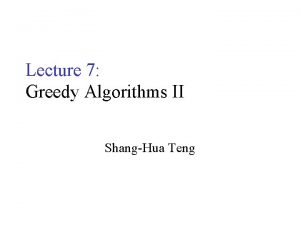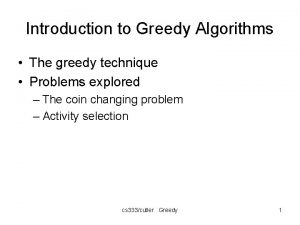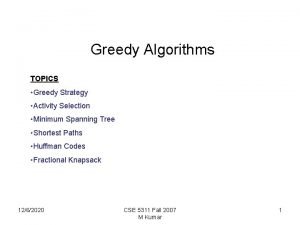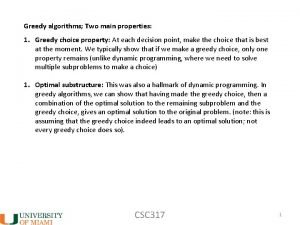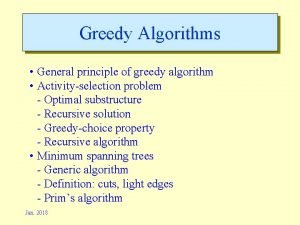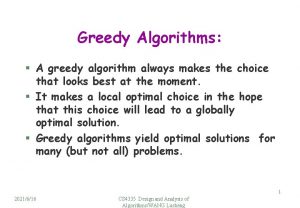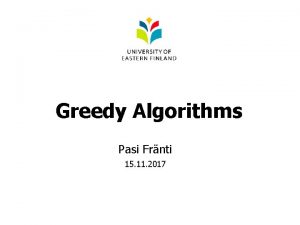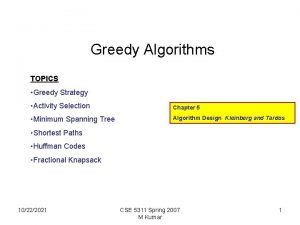Lectures on Greedy Algorithms and Dynamic Programming COMP













































![Sketch of the algorithm • Additional array M[0…n] initialized by 0, p(1), …, p(n) Sketch of the algorithm • Additional array M[0…n] initialized by 0, p(1), …, p(n)](https://slidetodoc.com/presentation_image/05748f2a91a522be102e285ab4e80e46/image-46.jpg)




![Algorithm finding max alignment • Initialize matrix M[0. . n, 0. . m] into Algorithm finding max alignment • Initialize matrix M[0. . n, 0. . m] into](https://slidetodoc.com/presentation_image/05748f2a91a522be102e285ab4e80e46/image-51.jpg)
![Complexity Time: O(nm) • Initialization of matrix M[0. . n, 0. . m]: O(nm) Complexity Time: O(nm) • Initialization of matrix M[0. . n, 0. . m]: O(nm)](https://slidetodoc.com/presentation_image/05748f2a91a522be102e285ab4e80e46/image-52.jpg)
![Reconstruction of optimal alignment Input: matrix M[0. . n, 0. . m] containing OPT Reconstruction of optimal alignment Input: matrix M[0. . n, 0. . m] containing OPT](https://slidetodoc.com/presentation_image/05748f2a91a522be102e285ab4e80e46/image-53.jpg)






- Slides: 59

Lectures on Greedy Algorithms and Dynamic Programming COMP 523: Advanced Algorithmic Techniques Lecturer: Dariusz Kowalski Greedy Algorithms and Dynamic Programming 1

Overview Previous lectures: • Algorithms based on recursion - call to the same procedure to solve the problem for the smallersize sub-input(s) • Graph algorithms: searching, with applications These lectures: • Greedy algorithms • Dynamic programming Greedy Algorithms and Dynamic Programming 2

Greedy algorithm’s paradigm Algorithm is greedy if : • it builds up a solution in small consecutive steps • it chooses a decision at each step myopically to optimize some underlying criterion Analyzing optimal greedy algorithms by showing that: • in every step it is not worse than any other algorithm, or • every algorithm can be gradually transformed to the greedy one without hurting its quality Greedy Algorithms and Dynamic Programming 3

Interval scheduling Input: set of intervals on the line, represented by pairs of points (ends of intervals) Output: the largest set of intervals such that none two of them overlap Generic greedy solution: • Consider intervals one after another using some rule Greedy Algorithms and Dynamic Programming 4

Rule 1 Select the interval that starts earliest (but is not overlapping the already chosen intervals) Underestimated solution! optimal algorithm Greedy Algorithms and Dynamic Programming 5

Rule 2 Select the shortest interval (but not overlapping the already chosen intervals) Underestimated solution! optimal algorithm Greedy Algorithms and Dynamic Programming 6

Rule 3 Select the interval intersecting the smallest number of remaining intervals (but still is not overlapping the already chosen intervals) Underestimated solution! optimal algorithm Greedy Algorithms and Dynamic Programming 7

Rule 4 Select the interval that ends first (but still is not overlapping the already chosen intervals) Hurray! Exact solution! Greedy Algorithms and Dynamic Programming 8

Analysis - exact solution Algorithm gives non-overlapping intervals: obvious, since we always choose an interval which does not overlap the previously chosen intervals The solution is exact: Let: • A be the set of intervals obtained by the algorithm, • Opt be the largest set of pairwise non-overlapping intervals We show that A must be as large as Opt Greedy Algorithms and Dynamic Programming 9

Analysis - exact solution cont. Let A = {A 1, …, Ak} and Opt = {B 1, …, Bm} be sorted. By definition of Opt we have k m. Fact: for every i k, Ai finishes not later than Bi. Proof: by induction. For i = 1 by definition of the first step of the algorithm. From i -1 to i : Suppose that Ai-1 finishes not later than Bi-1. From the definition of a single step of the algorithm, Ai is the first interval that finishes after Ai-1 and does not overlap it. If Bi finished before Ai then it would overlap with some of the previous A 1, …, Ai-1 and consequently - by the inductive assumption - it would overlap or end before Bi-1, which would be a contradiction. Bi-1 B i Ai-1 Greedy Algorithms and Dynamic Programming Ai 10

Analysis - exact solution cont. Theorem: A is the exact solution. Proof: we show that k = m. Suppose to the contrary that k < m. We already know that Ak finishes not later than Bk. Hence we could add Bk+1 to A and obtain a bigger solution by the algorithm - a contradiction. Bk-1 Ak Bk Bk+1 algorithm finishes selection Greedy Algorithms and Dynamic Programming 11

Implementation & time complexity Efficient implementation: • Sort intervals according to the right-most ends • For every consecutive interval: – If the left-most end is after the right-most end of the last selected interval then we select this interval – Otherwise we skip it and go to the next interval Time complexity: O(n log n + n) = O(n log n) Greedy Algorithms and Dynamic Programming 12

Textbook and Exercises READING: • Chapter 4 “Greedy Algorithms”, Section 4. 1 EXERCISE: • All Interval Scheduling problem from Section 4. 1 Greedy Algorithms and Dynamic Programming 13

Minimum spanning tree Greedy Algorithms and Dynamic Programming 14

Greedy algorithm’s paradigm Algorithm is greedy if : • it builds up a solution in small consecutive steps • it chooses a decision at each step myopically to optimize some underlying criterion Analyzing optimal greedy algorithms by showing that: • in every step it is not worse than any other algorithm, or • every algorithm can be gradually transformed to the greedy one without hurting its quality Greedy Algorithms and Dynamic Programming 15

Minimum spanning tree Input: weighted graph G = (V, E) • every edge in E has its positive weight Output: spanning tree such that the sum of weights is not bigger than the sum of weights of any other spanning tree Spanning tree: subgraph with – no cycle, and – spanning and connected (every two nodes in V are connected by a path) 1 3 2 1 2 Greedy Algorithms and Dynamic Programming 1 3 2 16

Properties of minimum spanning trees MST Properties of spanning trees: • n nodes • n - 1 edges • at least 2 leaves (leaf - a node with only one neighbor) MST cycle property: • after adding an edge we obtain exactly one cycle and each edge from MST in this cycle has no bigger weight than the weight of the added edge 1 3 2 1 1 2 Greedy Algorithms and Dynamic Programming 3 2 1 2 cycle 17

Crucial observation about MST Consider sets of nodes A and V - A • Let F be the set of edges between A and V - A • Let a be the smallest weight of an edge in F Theorem: Every MST must contain at least one edge of weight a from set F A 1 3 2 1 2 A 1 2 1 3 Greedy Algorithms and Dynamic Programming 2 18

Proof of the Theorem Let e be the edge in F with the smallest weight - for simplicity assume that such edge is unique. Suppose to the contrary that e is not in some MST. Consider one such MST. Add e to MST - a cycle is obtained, in which e has weight not smaller than any other weight of edge in this cycle, by the MST cycle property. Since the two ends of e are in different sets A and V - A, there is another edge f in the cycle and in F. By definition of e, such f must have a bigger weight than e, which is a contradiction. A 1 3 A 1 2 Greedy Algorithms and Dynamic Programming 3 2 19

Greedy algorithms finding MST Kruskal’s algorithm: • Sort all edges according to their weights • Choose n - 1 edges, one after another, as follows: – If a new added edge does not create a cycle with previously selected edges then we keep it in (partial) solution; otherwise we remove it Remark: we always have a partial forest 1 3 2 1 2 Greedy Algorithms and Dynamic Programming 1 3 2 1 2 20

Greedy algorithms finding MST Prim’s algorithm: • Select an arbitrary node as a root • Choose n - 1 edges, one after another, as follows: – Consider all edges which are incident to the currently build (partial) solution and which do not create a cycle in it, and select one having the smallest weight Remark: we always have a connected partial tree root 1 3 2 1 2 Greedy Algorithms and Dynamic Programming 1 3 2 1 2 21

Why the algorithms work? Follows from the crucial observations: Kruskal’s algorithm: • Suppose we add edge {v, w}; • This edge has a smallest weight among edges between the set of nodes already connected with v (by a path in already selected subgraph) and other nodes Prim’s algorithm: • Always chooses an edge with a smallest weight among edges between the set of already connected nodes and free nodes (i. e. , non-connected nodes) Greedy Algorithms and Dynamic Programming 22

Time complexity There are implementations using • Union-find data structure (Kruskal’s algorithm) • Priority queue (Prim’s algorithm) achieving time complexity O(m log n) where n is the number of nodes and m is the number of edges in a given graph G Greedy Algorithms and Dynamic Programming 23

Textbook and Exercises READING: • Chapter 4 “Greedy Algorithms”, Section 4. 5 EXERCISES: • Solved Exercise 3 from Chapter 4 • Generalize the proof of the Theorem to the case where may be more than one edges of smallest weight in F Greedy Algorithms and Dynamic Programming 24

Priority Queues (PQ) Implementation of Prim’s algorithm using PQ Greedy Algorithms and Dynamic Programming 25

Minimum spanning tree Input: weighted graph G = (V, E) • every edge in E has its positive weight Output: spanning tree such that the sum of weights is not bigger than the sum of weights of any other spanning tree Spanning tree: subgraph with – no cycle, and – connected (every two nodes in V are connected by a path) 1 3 2 1 2 Greedy Algorithms and Dynamic Programming 1 3 2 1 2 26

Crucial observation about MST Consider sets of nodes A and V - A • Let F be the set of edges between A and V - A • Let a be the smallest weight of an edge in F Theorem: Every MST must contain at least one edge of weight a from set F A 1 3 2 1 2 A 1 2 1 3 Greedy Algorithms and Dynamic Programming 2 27

Greedy algorithm finding MST Prim’s algorithm: • Select an arbitrary node as a root • Choose n - 1 edges, one after another, as follows: – Consider all edges which are incident to the currently build (partial) solution and which do not create a cycle in it, and select one which has the smallest weight Remark: we always have a connected partial tree root 1 3 2 1 2 Greedy Algorithms and Dynamic Programming 1 3 2 1 2 28

Priority queue Set of n elements, each has its priority value (key) – the smaller key the higher priority the element has Operations provided in time O(log n): • Adding new element to PQ • Removing an element from PQ • Taking element with the smallest key Greedy Algorithms and Dynamic Programming 29

Implementation of PQ based on heaps Heap: rooted (almost) complete binary tree, each node has its • value • key • 3 pointers: to the parent and children (or nil(s) if parent or child(ren) not available) Required property: in each subtree the smallest key is always in the root 2 4 3 7 5 6 2 3 4 7 5 6 Greedy Algorithms and Dynamic Programming 30

Operations on the heap PQ operations: • Add • Remove • Take Additional supporting operation: • Last leaf: Updating the pointer to the rigth-most leaf on the lowest level of the tree, after each operation (take, add, remove) Greedy Algorithms and Dynamic Programming 31

Construction of the heap Construction: • Start with arbitrary element • Keep adding next elements using add operation provided by the heap data structure (which will be defined in the next slide) Greedy Algorithms and Dynamic Programming 32

Implementing operations on heap Smallest key element: trivially read from the root Adding new element: • find the next last leaf location in the heap • put the new element as the last leaf • recursively compare it with its parent’s key: – if the element has the smaller key then swap the element and its parent and continue; otherwise stop Remark: finding the next last leaf may require to search through the path up and then down (exercise) Greedy Algorithms and Dynamic Programming 33

Implementing operations on heap Removing element: • remove it from the tree • move the value from last leaf on its place • update the last leaf • compare the moved element recursively either – “up” if its value is smaller than its current parent: swap the elements and continue going up until reaching smaller parent or the root, or – “down” if its value is bigger than its current parent: swap it with the smallest of its children and continue going down until reaching a node with no smaller child or a leaf Greedy Algorithms and Dynamic Programming 34

Examples - adding 2 2 3 4 3 7 5 6 1 add 1 at the end 7 2 3 4 7 5 6 1 1 5 6 4 swap 1 and 4 2 3 1 7 5 6 4 1 3 7 2 5 6 1 3 2 7 5 6 swap 1 and 2 4 Greedy Algorithms and Dynamic Programming 4 35

Examples - removing 2 3 6 4 3 7 5 6 removing 2 3 4 7 5 swap 2 and last element 2 3 4 7 5 6 6 3 4 7 5 3 5 4 6 4 7 5 remove 2 and swap 6 and 3 3 6 4 7 5 swap 6 and 5 3 5 4 7 6 Greedy Algorithms and Dynamic Programming 36

Heap operations - time complexity • Taking minimum: O(1) • Adding: – Updating last leaf: O(log n) – Going up with swaps through (almost) complete binary tree: O(log n) • Removing: – Updating last leaf: O(log n) – Going up or down (only once direction is selected) doing swaps through (almost) complete binary tree: O(log n) Greedy Algorithms and Dynamic Programming 37

Prim’s algorithm - time complexity Input: graph is given as an adjacency list • Select a root node as an initial partial tree • Construct PQ with all edges incident to the root (weights are keys) • Repeat until PQ is empty – Take the smallest edge from PQ and remove it – If exactly one end of the edge is in the partial tree then • Add this edge and its other end to the partial tree • Add to PQ all edges, one after another, which are incident to the new node and remove all their copies from graph representation Time complexity: O(m log n) where n is the number of nodes, m is the number of edges Greedy Algorithms and Dynamic Programming 38

Textbook and Exercises READING: • Chapters 2 and 4, Sections 2. 5 and 4. 5 EXERCISES: • Solved Exercises 1 and 2 from Chapter 4 • Prove that a spanning tree of an n - node graph has n - 1 edges • Prove that an n - node connected graph has at least n - 1 edges • Show to implement the update of the last leaf in time O(log n) Greedy Algorithms and Dynamic Programming 39

Dynamic programming Three problems: • Weighted interval scheduling • Sequence alignment • Distance between words Greedy Algorithms and Dynamic Programming 40

Dynamic Programming paradigm Dynamic Programming (DP): • Decompose the problem into series of sub-problems • Build up correct solutions to larger and larger subproblems Similar to: • Recursive programming vs. DP: in DP sub-problems may strongly overlap • Exhaustive search vs. DP: in DP we try to find redundancies and reduce the space for searching • Greedy algorithms vs. DP: sometimes DP orders subproblems and processes them one after another Greedy Algorithms and Dynamic Programming 41

(Weighted) Interval scheduling: Input: set of intervals (with weights) on the line, represented by pairs of points - ends of intervals Output: the largest (maximum sum of weights) set of intervals such that none two of them overlap Greedy algorithm doesn’t work for weighted case! Greedy Algorithms and Dynamic Programming 42

Example Greedy algorithm: • Repeatedly select the interval that ends first (but still not overlapping the already chosen intervals) Exact solution of unweighted case. weight 1 weight 3 weight 1 Greedy algorithm gives total weight 2 instead of optimal 3 Greedy Algorithms and Dynamic Programming 43

Basic structure and definition • Sort the intervals according to their right ends • Define function p as follows: – p(1) = 0 – p(i) is the number of intervals which finish before ith interval starts p(1)=0 weight 1 p(2)=1 weight 3 p(3)=0 weight 2 weight 1 Greedy Algorithms and Dynamic Programming p(4)=2 44

Basic property • Let wj be the weight of jth interval • Optimal solution for the set of first j intervals satisfies OPT(j) = max{ wj + OPT(p(j)) , OPT(j-1) } Proof: If jth interval is in the optimal solution O then the other intervals in O are among intervals 1, …, p(j). Otherwise search for solution among first j-1 intervals. p(1)=0 weight 1 p(2)=1 weight 3 p(3)=0 weight 2 weight 1 Greedy Algorithms and Dynamic Programming p(4)=2 45
![Sketch of the algorithm Additional array M0n initialized by 0 p1 pn Sketch of the algorithm • Additional array M[0…n] initialized by 0, p(1), …, p(n)](https://slidetodoc.com/presentation_image/05748f2a91a522be102e285ab4e80e46/image-46.jpg)
Sketch of the algorithm • Additional array M[0…n] initialized by 0, p(1), …, p(n) ( intuitively M[j] stores optimal solution OPT(j) ) Algorithm • For j = 1, …, n do – Read p(j) = M[j] – Set M[j] : = max{ wj + M[p(j)] , M[j-1] } p(1)=0 weight 1 p(2)=1 weight 3 p(3)=0 weight 2 weight 1 Greedy Algorithms and Dynamic Programming p(4)=2 46

Complexity of solution Time: O(n log n) • Sorting: O(n log n) • Initialization of M[0…n] by 0, p(1), …, p(n): O(n log n) • Algorithm: n iterations, each takes constant time, total O(n) Memory: O(n) - additional array M p(1)=0 weight 1 p(2)=1 weight 3 p(3)=0 weight 2 weight 1 Greedy Algorithms and Dynamic Programming p(4)=2 47

Sequence alignment problem Popular problem from word processing, graphics and computational biology • Input: two words X = x 1 x 2…xn and Y = y 1 y 2…ym • Output: largest alignment A: set of pairs (i 1, j 1), …, (ik, jk) such that • If (i, j) in A then xi = yj • If (i, j) is before (i’, j’) in A then i < i’ and j < j’ (no crossing matches) Greedy Algorithms and Dynamic Programming 48

Example • Input: X = c t t t c c Y = t c t t c c Alignment A: X=ctttct cc | || | | Y= t cttcc Another largest alignment A: X= ctttctcc ||| | | Y=tctt c c Greedy Algorithms and Dynamic Programming 49

Finding the size of max alignment Optimal alignment OPT(i, j) for prefixes of X and Y of lengths i and j respectively: OPT(i, j) = max{ ij + OPT(i-1, j-1) , OPT(i-1, j) } where ij equals 1 if xi = yj, otherwise is equal to - Proof: If xi = yj in the optimal solution O then the optimal alignment contains one match (xi , yj) and the optimal solution for prefixes of length i-1 and j-1 respectively. Otherwise at most one end is matched. It follows that either x 1 x 2…xi-1 is matched only with letters from y 1 y 2…ym or y 1 y 2…yj-1 is matched only with letters from x 1 x 2…xn. Hence the optimal solution is either the same as for OPT(i-1, j) or for OPT(i, j-1). Greedy Algorithms and Dynamic Programming 50
![Algorithm finding max alignment Initialize matrix M0 n 0 m into Algorithm finding max alignment • Initialize matrix M[0. . n, 0. . m] into](https://slidetodoc.com/presentation_image/05748f2a91a522be102e285ab4e80e46/image-51.jpg)
Algorithm finding max alignment • Initialize matrix M[0. . n, 0. . m] into zeros Algorithm • For i = 1, …, n do – For j = 1, …, m do • Compute ij • Set M[i, j] : = max{ ij + M[i-1, j-1] , M[i-1, j] } Greedy Algorithms and Dynamic Programming 51
![Complexity Time Onm Initialization of matrix M0 n 0 m Onm Complexity Time: O(nm) • Initialization of matrix M[0. . n, 0. . m]: O(nm)](https://slidetodoc.com/presentation_image/05748f2a91a522be102e285ab4e80e46/image-52.jpg)
Complexity Time: O(nm) • Initialization of matrix M[0. . n, 0. . m]: O(nm) • Algorithm: O(nm) Memory: O(nm) Greedy Algorithms and Dynamic Programming 52
![Reconstruction of optimal alignment Input matrix M0 n 0 m containing OPT Reconstruction of optimal alignment Input: matrix M[0. . n, 0. . m] containing OPT](https://slidetodoc.com/presentation_image/05748f2a91a522be102e285ab4e80e46/image-53.jpg)
Reconstruction of optimal alignment Input: matrix M[0. . n, 0. . m] containing OPT values Algorithm • Set i = n, j = m • While both i, j > 0 do • Compute ij • If M[i, j] = ij + M[i-1, j-1] then match xi and yj and set i = i - 1, j = j - 1; else • If M[i, j] = M[i, j-1] then set j = j - 1 (skip letter yj ); else • If M[i, j] = M[i-1, j] then set i = i - 1 (skip letter xi ) Greedy Algorithms and Dynamic Programming 53

Editorial distance between words Generalization of alignment problem • Input: – two words X = x 1 x 2…xn and Y = y 1 y 2…ym – mismatch costs pq, for every pair of letters p and q – gap penalty • Output: – (smallest) editorial distance between words X and Y Greedy Algorithms and Dynamic Programming 54

Example • Input: X = c t t t c c Y = t c t t c c Alignment A: (4 gaps of cost each, 1 mismatch of cost ct) X=c t t t c c | | | ^ | Y= t c t t c c Largest alignment A: (4 gaps) X= c t t t c c | | | Y= t c t t c c Greedy Algorithms and Dynamic Programming 55

Finding the distance between words Optimal alignment OPT(i, j) for prefixes of X and Y of lengths i and j respectively: OPT(i, j) = min{ ij + OPT(i-1, j-1) , + OPT(i-1, j) } Proof: If xi and yj are (mis)matched in the optimal solution O then the optimal alignment contains one (mis)match (xi , yj) of cost ij and the optimal solution for prefixes of length i-1 and j-1 respectively. Otherwise at most one end is (mis)matched. It follows that either x 1 x 2…xi-1 is (mis)matched only with letters from y 1 y 2…ym or y 1 y 2…yj-1 is (mis)matched only with letters from x 1 x 2…xn. Hence the optimal solution is either the same as counted for OPT(i-1, j) or for OPT(i, j-1), plus the penalty gap . Algorithm and complexity remain the same. Greedy Algorithms and Dynamic Programming 56

Textbook and Exercises READING: • Chapter 6 “Dynamic Programming”, Sections 6. 1 and 6. 6 EXERCISES: • All Shortest Paths problem, Section 6. 8 Greedy Algorithms and Dynamic Programming 57

Conclusions • Greedy algorithms: algorithms constructing solutions step after step by using a local rule • Exact greedy algorithm for interval selection problem in time O(n log n) illustrating “greedy stays ahead” rule • Greedy algorithms for finding minimum spanning tree in a graph – Kruskal’s algorithm – Prim’s algorithm • Priority Queues – greedy Prim’s algorithms for finding a minimum spanning tree in a graph in time O(m log n) Greedy Algorithms and Dynamic Programming 58

Conclusions cont. • Dynamic programming – Weighted interval scheduling in time O(n log n) – Sequence alignment in time O(nm) – Editorial distance between words in time O(nm) Greedy Algorithms and Dynamic Programming 59
 Greedy vs dynamic
Greedy vs dynamic Top down greedy approach
Top down greedy approach Greedy algorithms
Greedy algorithms N/a greedy
N/a greedy Huffman decoding for greedy algorithms
Huffman decoding for greedy algorithms Greedy algorithms
Greedy algorithms C programming lectures
C programming lectures Computational thinking algorithms and programming
Computational thinking algorithms and programming Synchronization algorithms and concurrent programming
Synchronization algorithms and concurrent programming Game programming algorithms and techniques
Game programming algorithms and techniques Dynamic programming vs divide and conquer
Dynamic programming vs divide and conquer Utilities and energy lecture
Utilities and energy lecture Theory of translation lectures
Theory of translation lectures Cell and molecular biology lectures
Cell and molecular biology lectures Dynamic dynamic - bloom
Dynamic dynamic - bloom Lcs tabulation
Lcs tabulation Matrix chain multiplication
Matrix chain multiplication Knapsack dynamic programming pseudocode
Knapsack dynamic programming pseudocode Steps in dynamic programming
Steps in dynamic programming Dynamic programming bottom up
Dynamic programming bottom up Features of dynamic programming
Features of dynamic programming Reliability design in dynamic programming
Reliability design in dynamic programming Dynamic programming excel
Dynamic programming excel Fibonacci sequence dynamic programming
Fibonacci sequence dynamic programming Egg acknowledgement
Egg acknowledgement Dynamic programming algorithm
Dynamic programming algorithm 4d3d41669541f1bf19acde21e19e43d23ebbd23b
4d3d41669541f1bf19acde21e19e43d23ebbd23b Multistage graph dynamic programming
Multistage graph dynamic programming Dma dynamic memory allocation
Dma dynamic memory allocation Assignment problem dynamic programming
Assignment problem dynamic programming Benefits of dynamic scheduling software
Benefits of dynamic scheduling software Advanced dynamic programming
Advanced dynamic programming Knapsack dynamic programming
Knapsack dynamic programming Dynamic programming paradigm
Dynamic programming paradigm Dynamic problem
Dynamic problem Dynamic programming paradigm
Dynamic programming paradigm Dynamic p table
Dynamic p table Gerrymandering dynamic programming
Gerrymandering dynamic programming Stagecoach problem
Stagecoach problem Canonical base
Canonical base Recursive thought
Recursive thought Minimum weight triangulation dynamic programming
Minimum weight triangulation dynamic programming Binomial coefficient using dynamic programming
Binomial coefficient using dynamic programming Manhattan tourist problem dynamic programming
Manhattan tourist problem dynamic programming Dynamic programming recursion example
Dynamic programming recursion example Algorithms for optimisation blackjack
Algorithms for optimisation blackjack Dynamic programming slides
Dynamic programming slides Dynamic programming recursion example
Dynamic programming recursion example Dynamic programming equation
Dynamic programming equation Dynamic programming
Dynamic programming Dynamic programming
Dynamic programming Characteristics of dynamic programming
Characteristics of dynamic programming Dynamic programming in excel
Dynamic programming in excel Levenshtein distance for oslo-snow
Levenshtein distance for oslo-snow Dynamic programming
Dynamic programming Dynamic programming
Dynamic programming Pseudoknot structure
Pseudoknot structure Dynamic programming
Dynamic programming Binomial coefficient dynamic programming
Binomial coefficient dynamic programming Gap strategy in dynamic programming
Gap strategy in dynamic programming


